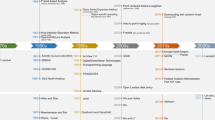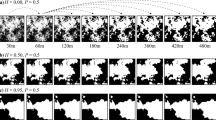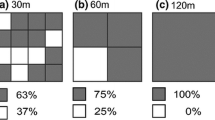Abstract
The resolution of satellite imagery must often be increased or decreased to fill data gaps or match preexisting project requirements. It is well known that a change in resolution introduces systematic errors of size, shape, location and amount of contiguous land cover types. Nevertheless, robust methods for rescaling landscape data are frequently required to assess patterns of landscape change through time and over large areas. We developed a new method for rescaling spatial data that allows map resolution (grain size) to be either increased or decreased while holding the total proportion of land cover types constant. The method uses a weighted sampling net of variable resolution to sample an existing map and then randomly selects from the frequency of cover types derived from this sample to assign the cover type for the corresponding location in the rescaled map. The properties of the sampling net had a variable effect on measures of landscape pattern with the characteristic patch size (S) the most robust metric and the number of clusters (A) the most variable. A comparison of up-scaled and down-scaled maps showed that this process is not symmetrical, producing different errors for increases versus decreases in grain size. Rescaling Landsat (30 m) imagery to the 10 m resolution of SPOT imagery for four National Park units within Maryland and Virginia resulted in errors due to rescaling that were small (1–2%) relative to the total error (∼11%) associated with these images. The new rescaling method is general because it provides a single method for increasing or decreasing resolution, can be applied to maps with multiple land cover types, allows grid geometry to be transformed (i.e., square to hexagonal grids), and provide a more consistent basis for landscape comparisons when maps must be derived from multiple sources of classified imagery.







Similar content being viewed by others
References
Anderson JR, Hardy EE, Roach JT, Witmer RE (1976) A land use and land cover classification system for use with remote sensor data. Washington, DC, U.S. Government Printing Office for the U.S. Department of the Interior, Geological Survey, 28 pp
Cihlar J (2000) Land cover mapping of large areas from satellites: status and research priorities. Int J Remote Sens 21:1093–1114
Congalton RG (1991) A review of assessing the accuracy of classifications of remotely sensed data. Remote Sens Environ 37:35–46
Costanza R, Maxwell T (1994) Resolution and predictability: an approach to the scaling problem. Landsc Ecol 9:47–57
Dodgson NA (1997) Quadratic interpolation for image resampling. IEEE Trans Image Process 6:1322–1326
Franklin SE, Wulder MA (2002) Remote sensing methods in medium spatial resolution satellite data land cover classification of large areas. Progr Phys Geogr 26:173–205
Gardner RH, Urban DL (2007) Neutral models for testing landscape hypotheses. Landsc Ecol 22:15–29
Gardner RH, Forester JD, Plotnick RE (2007) Determining pattern–process relationships in heterogeneous landscapes. In: Wu J, Hobbs RJ (eds) Key topics and perspectives in landscape ecology, Cambridge University Press
Ginzburg LR, Jensen CXJ (2004) Rules of thumb for judging ecological theories. Trends Ecol Evol 19:121–126
Grayson RB, Western AW, Chiew FHS, Bloschl G (1997) Preferred states in spatial soil moisture patterns: local and nonlocal controls. Water Resour Res 33:2897–2908
Grossman D, Goodin KL, Li X, Wisnewski C, Faber-Langendoen D, Anderson M, Sneddon L, et al (1994) Standardized national vegetation classification system, the nature conservancy and environmental systems research institute for the NBS/NPS vegetation mapping program. Denver, Colorado, National Biological Service
He HS, Ventura SJ, Mladenoff DJ (2002) Effects of spatial aggregation approaches on classified satellite imagery. Int J Geograph Inf Sci 16:93–109
Hlavka CA, Dungan JL (2002) Areal estimates of fragmented land cover: effects of pixel size and model-based corrections. Int J Remote Sens 23:711–724
Hlavka CA, Livingston GP (1997) Statistical models of fragmented land cover and the effect of coarse spatial resolution on the estimation of area with satellite sensor imagery. Int J Remote Sens 18:2253–2259
Jensen JR (1981) Urban change detection mapping using Landsat digital data. Am Cartogr 8:127–147
Kerr JT, Ostrovsky M (2003) From space to species: ecological applications for remote sensing. Trends Ecol Evol 18:299–305
Lu D, Weng Q (2007) A survey of image classification methods and techniques for improving classification performance. Int J Remote Sens 28:823–870
Ludwig JA, Bastin GN, Wallace JF, McVicar TR (2007) Assessing landscape health by scaling with remote sensing: when is it not enough? Landsc Ecol 22:163–169
Lunetta RS, Elvidge CD (1998) Remote sensing change detection: environmental monitoring methods and applications. Ann Arbor Press, Ann Arbor, MI
Mandelbrot B (1967) How long is the coast of Britain? Statistical self-similarity and fractional dimension. Science 156:636–638
Mandelbrot BB (1983) The fractal geometry of nature. Freeman, New York
Mayaux P, Lambin EF (1995) Estimation of tropical forest area from coarse spatial-resolution data—a 2-step correction function for proportional errors due to spatial aggregation. Remote Sens Environ 53:1–15
Milne BT (1992) Spatial aggregation and neutral models in fractal landscapes. Am Nat 139:32–57
Milne BT (1998) Motivation and benefits of complex systems approaches in ecology. Ecosystems 1:449–456
Moody A (1998) Using landscape spatial relationships to improve estimates of land-cover area from coarse resolution remote sensing. Remote Sens Environ 64:202–220
Moody A, Woodcock CE (1995) The influence of scale and the spatial characteristics of landscapes on land-cover mapping using remote sensing. Landsc Ecol 10:363–379
Moody A, Woodcock CE (1996) Calibration-based models for correction of area estimates derived from coarse resolution land-cover data. Remote Sens Environ 58:225–241
Plotnick RE, Sepkoski JJ (2001) A multiplicative multifractal model for originations and extinctions. Paleobiology 27:126–139
Plotnick RE, Prestegaard KL (1995) Fractal and multifractal models and methods in stratigraphy. In: Barton CC, LaPointe PR (eds) Fractals and their use in the petroleum industry. Plenum, New York, pp 73–96
Riitters KH (2005) Downscaling indicators of forest habitat structure from national assessments. Ecol Indic 5:273–279
Saupe D (1988) Algorithms for random fractals. In: Petigen H-O, Saupe D (eds) The science of fractal images. New York, Springer Verlag, pp 71–113
Shen W, Jenerette GD, Wu J, Gardner RH (2004) Evaluating empirical scaling relations of pattern metrics with simulated landscapes. Ecography 27:459–469
Singh A (1989) Digital change detection techniques using remotely-sensed data. Int J Remote Sens 10:989–1003
Solé RV, Manrubla SC, Benton M, Bak P (1997) Self-similarity of extinction statistics in the fossil record. Nature 388:764–767
Song C, Woodcock CE, Seto KC, Lenney MP, Macomber SA (2001) Classification and change detection using Landsat TM data: when and how to correct atmospheric effects? Remote Sens Environ 75:230–244
Song CM, Havlin S, Makse HA (2005) Self-similarity of complex networks. Nature 433:392–395
Stevens DL, Olsen AN (2004) Spatially balanced sampling of natural resources. J Am Stat Assoc 99:262–278
Townsend, PA, Lookingbill TR, Kingdon CC, Gardner RH (in review). Spatial pattern analysis for monitoring protected areas. Remote Sens Environ
Turner MG, O’Neill RV, Gardner RH, Milne BT (1989) Effects of changing spatial scale on the analysis of landscape pattern. Landsc Ecol 3:153–162
Vogelmann JE, Howard SM, Yang L, Larson CR, Wylie BK, Van Driel N (2001) Completion of the 1990’s national land cover data set for the conterminous United States from Landsat thematic mapper data and ancillary data sources. Programmetric Eng Remote Sens 67:650–662
Walsh TA, Burk TE (1993) Calibration of satellite classifications of land area. Remote Sens Environ 46:281–290
West GB, Brown JH, Enquist BJ (1997) A general model for the origin of allometric scaling laws in biology. Science 276:122–126
Wu J (2004) Effects of changing scale on landscape pattern analysis: scaling relations. Landsc Ecol 19:125–138
Wu J, Jones KB, Li HB, Loucks OL (2006) Scaling and uncertainty analysis in ecology: methods and applications. Dordrecht, The Netherlands, Springer, 351 pp
Yuan D, Elvidge C (1998) NALC land cover change detection pilot study: Washington DC area experiments. Remote Sens Environ 66:166–178
Acknowledgements
Special thanks to Clayton Kingdon and J. B. Churchill whose assistance with Landsat and SPOT imagery provided the data for testing the PDW algorithm. Access to the data for ground verification was provided by John Paul Schmit and is greatly appreciated. Funding was provided by the National Park Service, NCR I&M Network through the Chesapeake Watershed Cooperative Ecosystem Study Unit, Task Agreement J3992050104.
Author information
Authors and Affiliations
Corresponding author
Rights and permissions
About this article
Cite this article
Gardner, R.H., Lookingbill, T.R., Townsend, P.A. et al. A new approach for rescaling land cover data. Landscape Ecol 23, 513–526 (2008). https://doi.org/10.1007/s10980-008-9213-z
Received:
Accepted:
Published:
Issue Date:
DOI: https://doi.org/10.1007/s10980-008-9213-z




